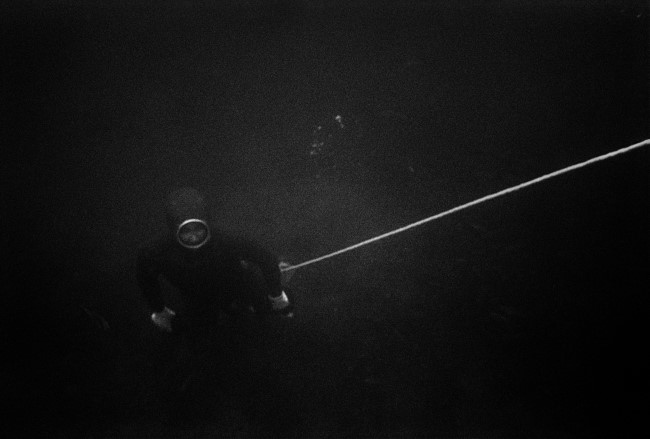| |
 |
|
| ▲ Modern haenyeo attire.They still dive without oxygen tanks.Photo by Kim Hungku |
In the past, haenyeo female divers, worked without clothes to pick up sea abalones and sea weed. Men used to dive with them. In Jeju culture, it was not considered embarrassing to swim naked with the opposite sex.
According to historical records, in 1105 (the 10th year of Goryeo King Sukjong’s reign), a local attaché called Yun Eung-gyun prohibited the “bare skin operation of haenyeo.” During the Joseon period, Injo (1623–1649) banned the co-operation of women and men at sea.
In 1629, during the late Joseon period, an exile named Lee Geon detailed in his essay "Jeju Customs" that “the female divers go underwater naked with a sickle to pick seaweed. I was astounded to see the men and women work together without feeling any shame.”
"Tamna Sullyeokdo" was painted in the early 1700s by artist Kim Nam-gil at the order of County Magistrate and Navy Commander Lee Hyeong-sang. It depicts haenyeo wearing white clothes as they dive near Yongduam Rock in Jeju-si.
| |
 |
|
| ▲ "Tamna Sullyeokdo," painted in the early 1700s by artist Kim Nam-gil at the order of County Magistrate-cum-Navy Deputy Commander Lee Hyeong-sang, depicts haenyeo wearing white clothes as they dive near Yongduam Rock in Jeju-si. Inside the white circle, you can see the haenyeo working under water. (Photo: Korean Maritime Museum Webzine) |
Reviewing these records, we can infer that haenyeo originally dived without clothes but began wearing clothes called "murot" from the early to mid-Joseon period. This was likely due to interference from mainland officials. Around this time, haenyeo also started using tools.
The clothes and tools were derived from existing farming equipment to enable them to be used in the tough seas and poor working conditions. The functionality and creativity of the tools shows the wisdom of the haenyeo’s.
"Murot" consists of "mulsojungi (bottom)," "muljeoksam (top)," and "mulsugeon" (head scarf that keeps the hair intact). The "Mulsojungi" has functional slits on the sides that make it easy to adjust and wear. Thanks to the practicality of covering the waist, chest, and torso, as well as keeping in body heat, women would often wear these clothes as underwear, even when they were not working in the sea.
In the Joseon period, "murot" were made of "mumyeong," white cotton fabric woven from traditional looms. During the Japanese occupation, they used machine-woven "gwangmok" fabric and dyed it black.
| |
 |
|
| ▲ "Muljeoksam" is a cotton clothing worn over "mulsojungi." It grew in popularly in the 1960s. Worn as a top to protect against cold and sunlight, its shape is between that of a hanbok and a western shirt. |
"Muljeoksam" was popularized comparatively later and is a white cotton shirt worn over "mulsojungi" and designed with narrow sleeves to minimize the resistance from water. It was also used to cover the divers’ backs and shoulders when they dried themselves in front of fire after work.
Fishing tools used by haenyeo include "tewak mangsari," "bitchang," "homaengi," and "jokswenun." "Tewak" is a buoy and is used by the divers to let them take a break on water. Alternatively, the divers can swim while leaning over it with a net attached to store collected seafood. The two pieces function together as a set.
| |
 |
|
| ▲ "Sojungi" is a type of clothing worn by haenyeo when they dive. At first, the divers only wore the bottom part, but over time it came to cover the upper body too. Suspenders called "maechin" were later added and hang over the shoulders. They were mostly white, but because of stains, they were also made with black or dark cloth. (Photo: Haenyeo Museum) |
In the past, haenyeo used to drill holes on a large gourd to remove the seeds and block it to make "tewak." Recently, more conventional materials such as plastic or styrofoam are used.
"Bitchang" is a tool for removing sea abalones stuck on the boulders, "jonggaehomi" is for collecting seaweed such as sea mustard, hijiki, and gulfweed. "Homaengi" resembles a hoe, but is longer and thinner and used for capturing conch, octopus, and sea urchin.
These tools are variations of hoes and sickles used for farming. Haenyeo would have ordered these tools from the local blacksmith.
"Jokswenun" is a two-lens swimming goggle, and "swenun" is a single-lens goggle. The glass lenses are finished with brass or copper on the rim. In 2008, 15 such types of attire and tools were officially designated as part of Jeju Folklore.
There is also a rubber suit called "gomuot" that consists of a headpiece that covers the neck, a top with hooks, pants that cover the area from the ankles to the chest, and flippers. Because the rubber suit is buoyant, haenyeo must wear lead weights to dive in the water. Since the advent of rubber suits, the working environment has vastly transformed for haenyeo. They used to be able to work for just 30 minutes to an hour. With the rubber suits, they can work up to five hours at a time and in much deeper places.
Diving into deeper waters at a depth of up to 20m can result in side effects such as diver’s disease and concerns about the devastation of sea farms. Nonetheless, the rubber suits are widely distributed as the haenyeo observe self-control, increase their profits, and make their work more convenient. As the black color is difficult to notice, orange diving suits have been distributed since 2012 to prevent accidents such as collisions with ships. |























